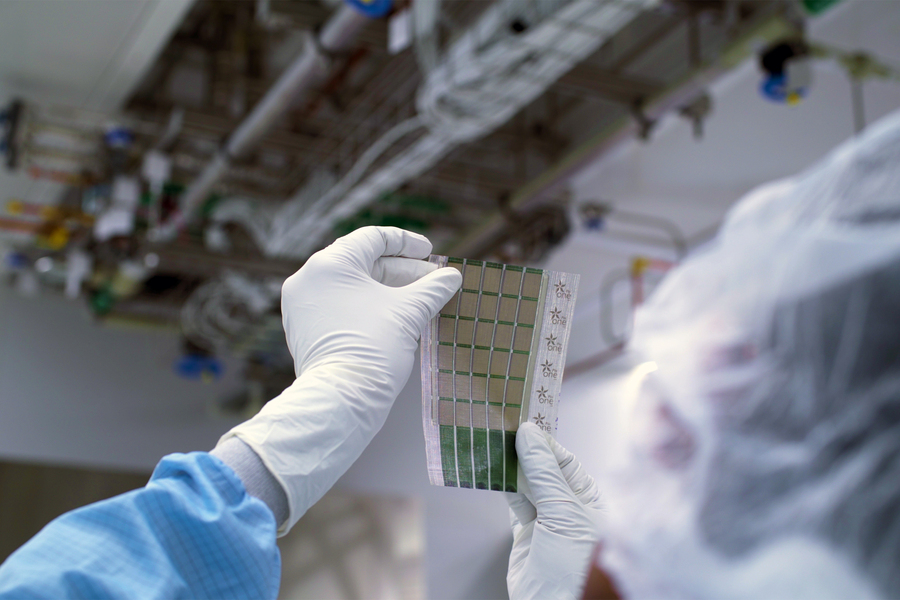A research team at the Massachusetts Institute of Technology (MIT) has developed a technique to print durable, flexible solar cells that are thinner than a human hair. The lightweight PV can be easily affixed to any surface like a sticker, quickly turning any surface to a productive renewable energy generator.
The cells are one-hundredth the weight of conventional solar panels and generate 18 times as much power-per-kilogram. They are made from nanomaterial semiconducting inks using printing processes that the researchers can readily scale for large-area manufacturing.
The fabric solar cells are 50 microns thin and achieve a specific power of 370 W per kg. For reference, a human hair is 70 microns thick.
The thin, lightweight solar cells have many potential applications, including integration into boat sails, adhered to the side of tents, or applied to the wings of drones. The MIT team deposited the printed solar cells on Dyneema fabric, a sturdy tarp-like substance popular in the ultralight hiking world, making the cells sturdy while not sacrificing the flexibility and light-weight properties.
“The metrics used to evaluate a new solar cell technology are typically limited to their power conversion efficiency and their cost in dollars-per-watt. Just as important is integrability — the ease with which the new technology can be adapted. The lightweight solar fabrics enable integrability, providing impetus for the current work. We strive to accelerate solar adoption, given the present urgent need to deploy new carbon-free sources of energy,” says Vladimir Bulović, MIT researcher and senior author of the report.
Conventional solar cells are encapsulated in glass and aluminum frames, limiting where they can be installed. A typical Massachusetts rooftop solar installation is about 8 kW, adding about 1,000 lbs. to a roof. The Dyneema-affixed solar cell would only add 44 lbs. to produce the same amount of power.
The cells have resisted stress-tests well. After rolling and unrolling a fabric solar panel more than 500 times, the cells still retained more than 90% of their initial capacity.
In 2016, a team from ONE Lab produced solar cells using emergent thin-film materials that were lightweight enough to sit atop a soap bubble. However, the cells were manufactured using complex, vacuum-based processes, an expensive and challenging task to scale up. The new MIT-developed solar fabrics are entirely printable, making them scalable for large-area production.
The cells are made with printed electronic inks, coating the solar cell structure using a slot-die coaster, which deposits layers of electronic materials onto a prepared, resealable substrate. Using a screen-printing process similar to T-shirt design printing, an electrode is deposited on the structure to complete a solar module. The module is then peeled from the substrate, and later affixed to the Dyneema fabric for stability.
This content is protected by copyright and may not be reused. If you want to cooperate with us and would like to reuse some of our content, please contact: editors@pv-magazine.com.









Many reading this article are seeing how much power the fabric produces per kg, but asking how much power it produces per m2. Why are these figures so conspicuously absent from the article and from the reports it was based on!?
I also do not appreciate the odd implication that one can simply substitute 1000lbs of roof-mounted solar panels with 55lbs (18X less weight) of this fabric. The fabric produces roughly 1/4 the energy of a typical solar panel given the same area, see math below:
According to the following report from ‘Small Methods’, this fabric solar has 18X the power to weight ratio and 100X less weight per m2 than a SunPower’s Maxeon Gen 5, 400 W Residential A-Series Panel: https://onlinelibrary.wiley.com/doi/10.1002/smtd.202200940
Fortunately, this gives us enough data to solve for X:
The 400W Maxeon Gen 5 weighs 20kg and is 1.87m2, weighs 10.7kg/m, & produces 214W/m2
The solar fabric weighs 0.2kg/m2 and produces 370W/kg, therefore one square meter of fabric has a capacity of: >>>>>> 74W/m2 <<<<<<
If the fabric were the size of a 600W commercial panel, it would have a capacity of around 150W. Not bad for a lightweight piece of fabric!!! Why was everyone trying to keep these important numbers a secret?